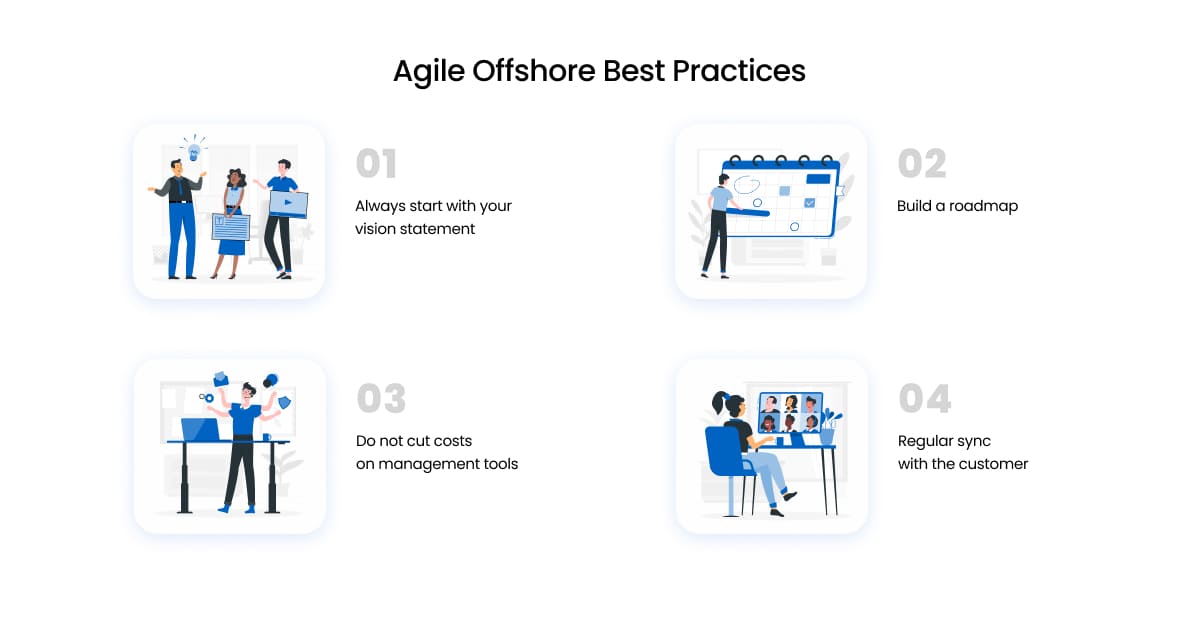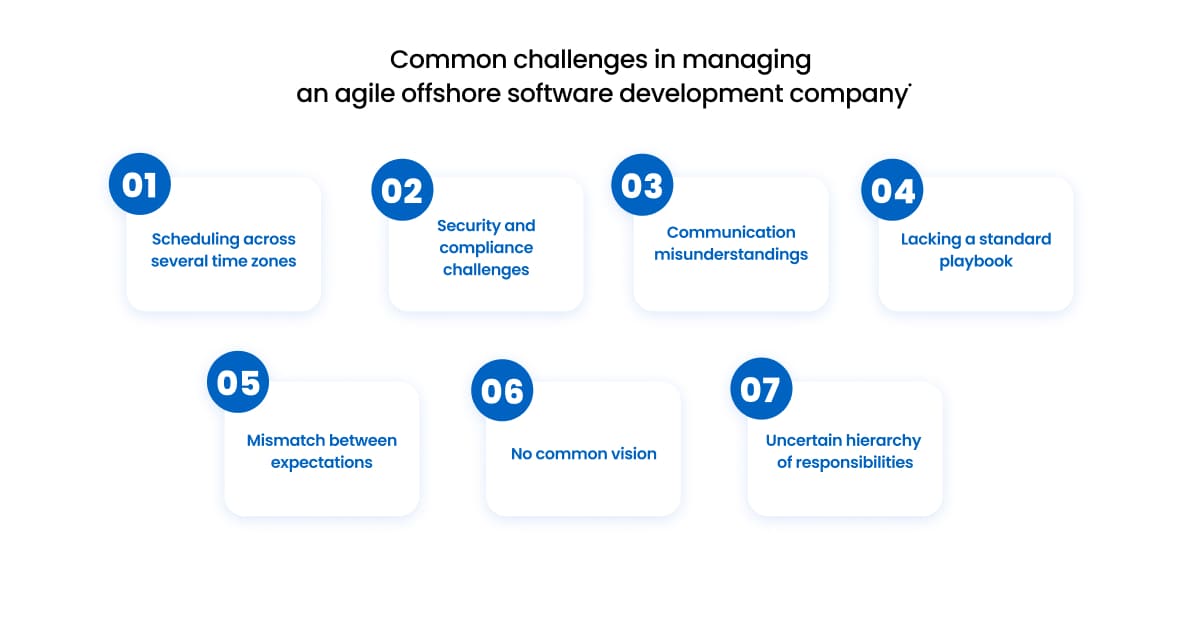
How To Work With an Agile Offshore Development Team



No other labor market segment boasts such an impressive statistical growth as IT outsourcing and outstaffing. And that’s not because most of us are working from home these days.
In 2022, 54% of all companies used third parties to provide support and customer care services. At the moment, there are over 59 million freelance workers in the US alone, and this number only continues to grow.
At the same time, despite millions of US-based freelancers, 300k more jobs are outsourced annually, primarily for economic reasons. Almost 93% of all organizations around the world have tried or are currently outsourcing for at least one project.
Outsourcing is especially widespread in the IT industry: from development and QA to UI/UX, PPC, and SEO campaigns — everything gets outsourced. The reasons why companies choose to outsource software development vary. Reasons range from cost-saving and tax optimization to more intricate things like headhunting for unique talents in geographically distant localities.
Additionaly, white label marketing services have become a significant aspect of outsourcing, allowing companies to expand their service offerings under their own brand without the need to develop in-house expertise.
Most of the reasons behind outsourcing and outstaffing in IT are efficiency-related though. These include saving time through parallel development of multiple projects, solving problems with an accumulated backlog, managing complex projects across several time zones, and so on.
Managing offshore development is very different from traditional modes of project management, and it’s not because of cultural differences, time zone gaps, or language misunderstandings. Hiring and supervising an offshore development team would have come with its own set of truly unique challenges.
Thus, methods for successfully raising efficiency in offshore team management are very different from what you would find in a standard business management textbook.
Coordination is the key to managing offshore teams. For this very reason, agile methodology has become the worldwide standard among developers and project managers. Following Agile principles delivers flexibility while leaving the door open for continuous improvement.
Content
Truth be told, Agile has become an overused buzzword. Though this does not mean that anyone can easily come up with a precise definition.
Let’s use Atlassian’s definition as a globally acknowledged software leader: “Agile is an approach to project management and software development that helps teams deliver value to their customers faster and with fewer headaches… Agile teams deliver work in small but consumable increments. Requirements, plans, and results are evaluated continuously.”
Continuous delivery and constantly changing requirements belong to the 12 key principles of Agile.
In other words, agile is a framework under which ongoing delivery of a project is based on self-organization principles and change-adjusted management of a system of small tasks. Just as any other management novelty, introducing Agile would require a step-by-step approach. If you are already involved in programming outsourcing and offshore development, we recommend following the logic below.
Your team can be in five different countries at the same time but must still be on the same page. Scope of Work (SOW) is the key here. SOW outlines the key objectives and the overall timeline of your project along with the reporting agenda.
Once SOW is defined, the overall project gets split into parts. Each part is then divided into smaller tasks. Each task is initially assigned its own priority weight. However, this priority status is subject to change, depending on the feedback from internal stakeholders or changes in the external environment. The entire SOW must be presented and explained to the whole team as early as possible.
As multiple tasks under the same SOW would be performed in parallel, having a common timeline is a vitally necessary prerequisite for any complex project.
If you are having trouble visualizing the timeline, there are many online tools to help you compile a roadmap. Monday and Asana are probably the most popular examples of roadmap planning software (note that most of these tools have free trial options, so you can test a few and decide).
It is important to note here that the goal of building a single roadmap for your entire team is NOT to impose deadlines. The priority here is to provide a clear view of the overall concept of your project.
Deadlines, in fact, should be relatively easy to extend. Keep in mind that this is Agile — flexibility and changes on the go are the cornerstones of the entire operation.
When working with an offshore team, you are sure to save on renting an office. These unspent funds should be invested in collaboration software. It could be a good idea to start with something as simple as Zoom: having free plans in Zoom means you can’t record meetings, and these meetings would be limited to 40 minutes. Having a few paid plans would save your team from many misunderstandings and confusion.
Trello or Jira, Confluence or GitHub, Slack or Microsoft Teams — this is all very much to your benefit. The budget differences are not that dramatic in this segment of online tools. You can simply ask your offshore team to vote on their preferences.
Constant communication is the major difference between Agile projects and traditional ones. Team communication with the end customer should be part of the daily routine. The development process must start with a detailed customer interview.
Testing should always be recorded and then delivered to the customer. Every single feature, even the most insignificant, should have customer feedback of its own.
PM or other team members should step in as an intermediary if you anticipate any misunderstandings in this communication due to language barriers or cultural differences. In exceptional cases, hiring an interpreter for just an hour can save you dozens of hours of development time (and no, this is not a sign that your offshore team is unprofessional).
Even if you follow Agile offshore best practices very thoroughly, there might still be challenges on your way to sustainable and flexible offshore team management. Some of these challenges are actually quite widespread, and there are ways to prevent (avoid) them, at least partially.

If your teammates are based in South East Asia, Europe, or US/Canada, scheduling mandatory online meetings can be a real problem. Make sure everyone has easy access to each other’s calendars. It is also good to have a joint list of national/bank holidays for every country involved. The same applies to joint calendar vacations and days off.
If your product (service) is already live on the market and requires permanent support, it is most advisable to have support reps in at least two time zones that do not overlap. Thus, you would guarantee your very first customers can get help whenever they need it.
Do not assume that if you’ve hired IT people, they cannot become victims of phishing attacks or other scams. They may still receive an email from a “fake boss account”, or get caught in a rush and come up with a password as easy as 1234.
Besides, many offshore developers choose to work in a workcation mode, often using unsecured WiFi networks somewhere at a beach hotel or in a village cafe. Your early developments can be easily compromised.
Basic security training must be organized at least every six months. If you don’t have an in-house compliance officer — hire a freelance consultant for two or three hours once in a while. Investing in security is never a waste.
If your agile development team is scattered across several countries, that does not mean it cannot have a corporate culture feel. For one, everyone should be on the same page regarding your mission, vision, and values.
Do not disregard the onboarding process. Even for very temporarily hired freelancers or purely technical contractors who won’t be anywhere around your frontend, design, content, or customer reach out. Precise understanding of the product’s value and mission strengthens employee engagement and boosts efficiency.
Having a clearly written code of conduct is probably the most efficient way to avoid language confusion and intercultural misunderstanding between remote workplaces.
This Code does not have to be a 50-page long legal manual. It can be as short as 10-12 plain statements, like: “All chat communication is in English only”, or “If you go on vacation, indicate the final day of your vacation in your status”, or “Move tasks to Done on the same day as they are completed”.
These tiny things may seem insignificant, but in the long run, they become tremendous contributors to higher overall productivity. Besides, the Code will help you prevent many potential interpersonal misunderstandings.
It is a widespread problem of many large organizations and remote teams when people from two different teams/projects are talking about the same thing, but calling it something different. Having a common vocabulary and consistency across all processes is highly important. Your playbook can be a simple Google Doc, a Wiki project, or it can be documented in Confluence. Make sure everyone knows where to look up your glossary of terms.
Offshore development teams need hierarchy too. Of course, it doesn’t have to be as rigid as a corporate one. But a hierarchy must be present and well documented. Ideally, it also needs to be visualized. Every member of your agile development team should be aware of which responsibility center is specifically accountable for.
Note that having an internal hierarchy in your team does not mean that communications have to be hierarchical. A team member should still be able to reach out to any other team member, across the teams, and disregard any hierarchies.
As mentioned above, Agile offshore development is based on ongoing changes and continuous delivery. As changes become regular, teams’ expectations regarding each other’s performance also change. Make sure all sides are on the same page in terms of expectations.
The internal client should always start their conversation about change with clear instructions and a detailed explanation of the necessity of change and its targets. Milestone meetings must always be recorded, with the minutes carefully taken and a follow-up summary emailed to all the invited team members.

Obviously, both modes have their advantages and bottlenecks. If delegating is a psychological pain for you, and you are more into helicopter management — feel no shame for it and simply go for in-house development in its entirety.
However, you need to be prepared to embrace more of the daily routine and more recurring costs at the same time. Which, unfortunately, does not always mean higher productivity and more work done.
Agile methods are still rocking the software world as a go-to for development. With remote setups and tech changes, Agile’s flexibility and teamwork make even more sense. It’s like a speed booster, keeping things moving quickly, customers happy, and teams in sync, all in today’s crazy business buzz. When it comes to collaborating with an outsourcing development company, Agile becomes particularly invaluable, facilitating seamless coordination and efficient outcomes.
Sergii PoznokosDelivery Manager, Glorium Technologies
Managing several geographically distant teams might be a real challenge, especially now, when international travel is very much restricted. But it also comes with a range of unique benefits:
Agile is what makes offshore software development almost invincible. Increased flexibility and continuous improvement under Agile means you can manage multiple complex projects in parallel, without making any sacrifices in terms of human or tech resources.
On the manager’s side, Agile delivers much higher project predictability and reduced risks of project failure. On the customer’s side, Agile means more open communication with the executors and transparency throughout the entire timeline of a project.
Finally, Agile delivers multiple benefits for developers themselves, both organizational and psychological. Agile offshore development means higher adaptability of work-in-progress to sudden changes and other externalities.
Agile provides complete transparency and clear accountability for each process, no matter how small. On the human side, Agile contributes to stronger team spirit, fair work/life balance, and much lower professional burnout among developers.
The outsourcing and outstaffing market, particularly in the field of IT, has experienced significant growth, with millions of freelance workers and a rising trend in outsourcing various tasks, from software development to customer support. Agile methodology has become a standard approach for managing offshore development teams due to its flexibility, continuous improvement, and ability to accommodate various challenges.
Agile methodology, with its adaptability and emphasis on communication and collaboration, is well-suited for managing offshore development teams and projects in the dynamic IT industry.
By breaking down complex projects into smaller, manageable iterations, Agile enables offshore teams to respond swiftly to changing requirements and market demands. Regular feedback loops and continuous integration of stakeholders’ inputs foster a shared understanding of project goals and priorities, enhancing team alignment despite geographical distances.
The methodology’s iterative nature promotes incremental progress, ensuring that offshore teams can deliver value more frequently and with greater flexibility. Through methods such as daily stand-up meetings and frequent retrospectives, Agile enhances transparency and facilitates the resolution of any impediments that may arise, ensuring that offshore projects stay on track.
Ultimately, the Agile methodology not only maximizes the efficiency of offshore development teams but also cultivates a culture of adaptability, collaboration, and innovation that resonates well with the ever-evolving nature of the IT industry.
An agile offshore software development company specializes in providing remote software development services using agile methodologies. This involves assembling a skilled team of developers situated in different geographic locations to collaboratively create software solutions.
Agile offshore development involves a team of software developers working from a distinct geographical location. They use agile methodologies to create software solutions, collaborating closely with clients to ensure timely and iterative development.
Offshore agile software development offers advantages such as cost-effectiveness, access to a diverse talent pool, efficient use of agile methodologies, and the ability to cater to different time zones, resulting in faster development cycles.
Offshore agile development stands out due to its emphasis on iterative development, continuous communication, and flexibility. It leverages agile methodologies to accommodate changing requirements and deliver high-quality software.
Effective communication in an agile offshore development team is facilitated through video conferencing, regular stand-up meetings, instant messaging, and collaborative tools. This enables seamless interaction between team members in different locations.
Yes, agile methodologies like Scrum and Kanban are well-suited for offshore development. They allow for adaptable planning, iterative development, and real-time feedback, ensuring efficient collaboration across different time zones.
Productivity in offshore agile development is ensured by providing teams with essential tools such as Jira, Trello, and Slack, allowing efficient task management, progress tracking, and communication across locations.
An agile offshore software development company acts as a partner that assembles and manages skilled teams for clients’ software projects. They implement agile methodologies to deliver high-quality software within agreed timelines.
Absolutely, offshore software development services can effectively utilize agile methodology to ensure collaborative development, adaptability to changing requirements, and regular client engagement for successful project outcomes.
Offshore agile development positively impacts project timelines by promoting incremental progress and continuous feedback. This iterative approach enhances software quality, meeting evolving client needs while maintaining rigorous standards.
Offshoring involves relocating tasks or teams, often for cost savings, but communication challenges can arise due to geographic distance. Product development outsourcing offers several benefits, including access to specialized expertise, cost savings, accelerated time-to-market, and the ability to focus on core competencies.
Choose offshoring vs outsourcing based on your digital project needs and priorities.
On-demand app development refers to the process of creating mobile or web applications that connect service providers or vendors directly with users who require specific services or products in real-time. These apps facilitate immediate access to services, allowing users to request and receive assistance, products, or experiences whenever they need them.








